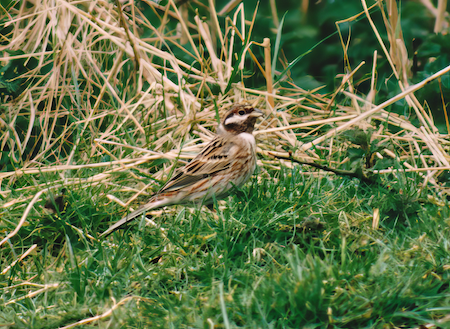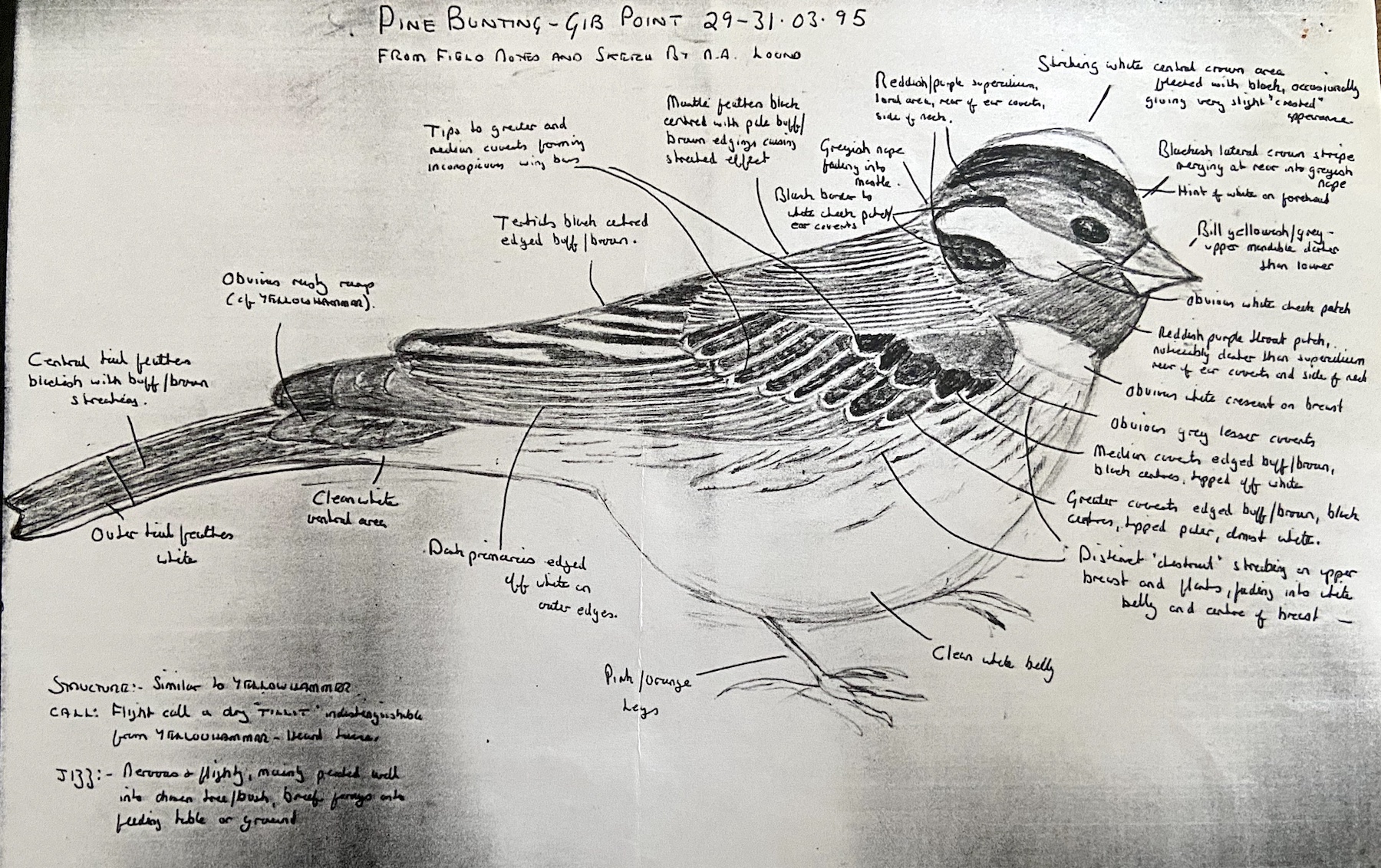Pine Bunting Emberiza leucocephalos
Vagrant. Siberia.

One county record at Gibraltar Point NNR March 29th– 31st 1995 of an elusive 2CY male found in the Plantation feeding station with Chaffinches and Yellowhammers, an exceptional find. During its stay the bird remained very elusive and showed well on only a few occasions, always in the area of the feeding station. It preferred to perch inside numerous hawthorn bushes, only rarely venturing out to give good views on the outer branches. When it came to the bird tables to feed on grain, it preferred to forage for spilt grain on the ground, where it was often dominant. The bird was last seen at 18:00hrs on March 31st. This bird remains the only county record.
The issue of hybridisation with Yellowhammers, E. citrinella, has been well covered in the general ornithological literature. The bird's entire plumage must be scrutinised for any residual yellow tones with the fringes of the primaries being the best place to look as this is often the last place where yellow is shown in more troublesome hybrids and backcrosses. It has been known for birds with no other suggestion of hybridisation to exhibit conflicting colour only in the underwing coverts or at the concealed bases of the crown feathers. Three hybrid birds were reported by the BBRC in their 2019 report but there were no issues with ‘our’ bird - particular attention was paid to the primary and secondary feather edgings, where there was no trace of yellow. It was tentatively aged as a second calendar year bird due to the streaking on the crown and face. Shirihai et al. (1995) provide good advice on the field identification of Pine Buntings, as does Occhiato (2003) who includes more information on hybrids.
Pine Buntings are widespread breeding birds in Siberia west to the Urals, where they just about get into the European foothills. It migrates south across Asia in the non-breeding season, but in the Western Palearctic it has been a regular if localised winter visitor to northern Israel, and a scarce/rare winter visitor to Italy and rarer still to southern France. Elsewhere in Europe, it is only a rare vagrant, with a tendency to show up during the winter months. There have been two British records to 1949 and 61 1950-2019 so it remains a much sought after species averaging only 1-2 records per year. Overall though it has averaged just over one bird per year since the mid 1970s, with peaks of four in 1987, 1994 and 1995, and nine in 2016 (when there were also 13 Siberian Accentors, Prunella montanella, though none in Lincolnshire)! The majority have occurred in October or November.
| Site | First date | Last date | Count | Notes |
| Gibraltar Point NNR | 29/03/1995 | 31/03/1995 | 1 | 2CY male |
Finder’s report: Pine Bunting at Gibraltar Point NNR, March 29th, 1995: first county record.
by N. A. Lound
Note: this account is based on the article in the Lincolnshire Bird Report 1995, with reference to the original BBRC submission. The BBRC report for 1995 noted that this had been another good year for Pine Buntings with another two other records, bringing the total for Great Britain to 30. The report also noted the problem of hybrids with Yellowhammer E. citrinella, which can cause real problems. Some of these can show all the characters of Pine Bunting, with the only Yellowhammer character being the presence of yellow tones in the fringes of the inner primaries. One such example was a male showing yellow primary fringes on Fair Isle, Shetland, on October 29th, 1995.
Circumstances
Having had a quiet day in the field seeing nothing of note, I went to the hide overlooking Lambert’s Pond on the Gibraltar Point NNR at 12.15 pm, March 29th, 1995. This area has a regular feeding station for birds, and it was my intention to see if any ‘new’ birds had been attracted due to cold weather over the past 3-4 days, as there had been a covering of snow and sub-zero temperatures at night.
After 20 minutes or so, seeing plenty of birds but nothing out of the ordinary, I saw a bird drop from a nearby tree on to the ground beneath the nearest feeding table about 10 m. away. However, once I looked at the bird through ‘bins’ I immediately dismissed both Reed and Rustic Buntings and my spinning head settled on male Pine Bunting, a bird that I had read about but never expected to find. The bird remained on the ground for about 20 seconds then flew into the same tree from which it had dropped, giving an excellent view from the rear for about a minute. It then flew off into the Plantation and out of sight. I hurriedly wrote down the following brief note:
On deck below feeding table, white line below eye, broad white median crown stripe, rusty rump (cf. Yellowhammer), rusty throat patch, chestnut-red streaks on flanks. Flight call as it flew into tree identical to Yellowhammer. Appeared stockier than Reed Bunting – almost ‘crested’ appearance on ground due to ‘fluffed up’ median crown stripe (?). As the bird was no longer showing I immediately went to the Field Station to grab the first Field Guide I could find. This left me in no doubt and shortly afterwards I found K. M. Wilson and conveyed the unbelievable news. We returned to the Lambert’s Pond area and were soon joined by Juan Brown. The bird was relocated about 14.00 hr. the same day when it showed for 20 minutes, enabling better views and description to be obtained. I also saw the bird from 06.50-07.15 hr. on March 31st. It was not seen again after about 18.00 hr. on this date. The following detailed description was compiled by NAL, KMW and Mark Grantham.
Description
General appearance – a solid, well-marked bunting, similar in size and shape to nearby Yellowhammers.
Head and crown – broad white central crown area extending from forehead backwards merging into nape. Black lateral crown stripe, with black streaks merging into central crown area (causing the slight ‘crested’ appearance noted by NAL?). Supercilium, loral area, rear of ear coverts and inner side of neck all reddish-brown, surrounding conspicuous whiter cheek patch extending from bill to ear coverts, where bordered black at rear of ear coverts. Yellowish eye ring (KMW).
Upperparts – greyish nape and shawl merging into mantle. Mantle feathers black centres with pale buff-brown edges giving streaked appearance. Primaries dark brown-grey, edged off-white (NAL), steely greyish-white (KMW) or silvery-white (MG). Wing length equal to extent of longest uppertail coverts (KMW). Tertials black-centred, broadly edged buffish-brown. Median coverts black arrow-shaped centres (MG), edged buff-brown (NAL/MG), broadly tipped off-white (KMW). Lesser coverts greyish. Underwing coverts white (MG). Buffish tips to greater and median coverts formed inconspicuous wing bars.
Particular attention was paid to the primary and secondary feather edgings, where there was no trace of yellow.
Tail – central tail feathers blackish with buff-brown streaking, similar to mantle. Outer tail feathers white. Tail separated from mantle by extensive rusty rump, clearly visible when at rest and in flight (cf. Yellowhammer).
Underparts – chin and throat dark reddish-brown (darker than face surround), NAL), sharply demarcated from upper breast by white crescent. Upper breast heavily streaked rufous-chestnut, extending in broad band to rear of flanks and rump. Clean white belly.
Bare parts – legs pink-orange (NAL/KMW), dull orange (MG). Bill dark grey (KMW) to yellow grey with upper mandible noticeably darker than lower.
Behaviour – during its brief stay the bird remained very elusive, showing well on only a few occasions, always in the area of the feeding station. When located the bird often preferred the inner sanctuary of numerous Hawthorn bushes, only rarely venturing out to give good views perched on outer branches. The bird came to bird table to feed on grain but often preferred to forage for spilt grain on the ground, where it was often dominant. The bird was tentatively aged as 1CY due to the streaking on the crown and face.

Sketch of the Pine Bunting at Gibraltar Point NNR from the original BBRC submission by N. A. Lound.
References
(Updated with reference to the new Birds of Lincolnshire (2021) January 2023)

